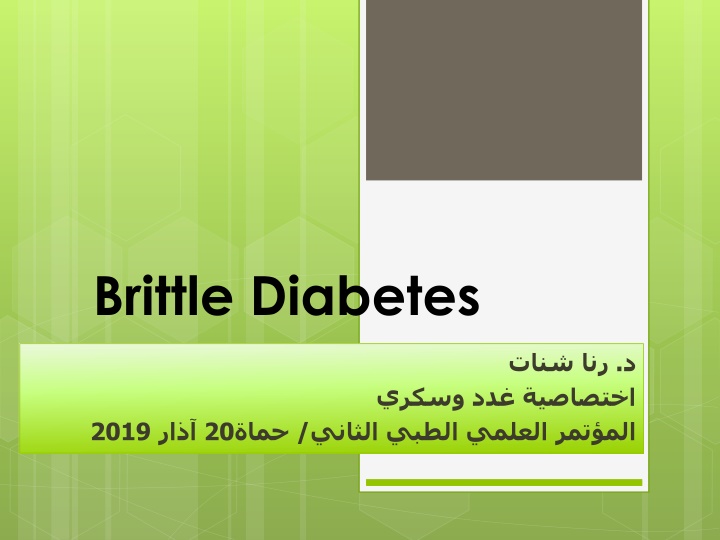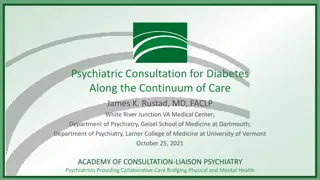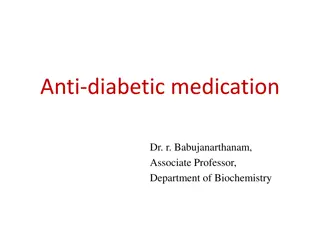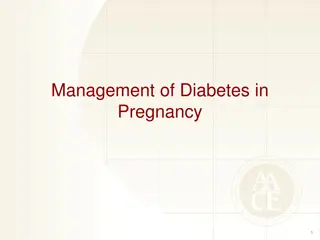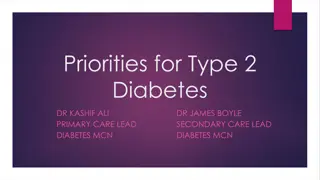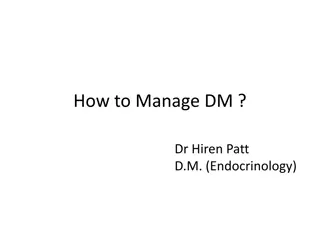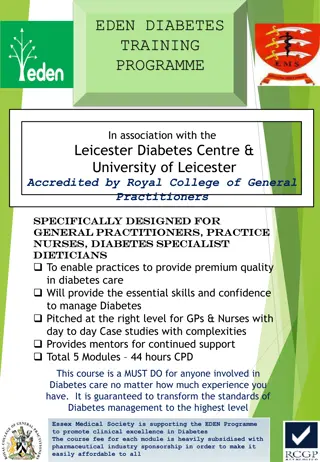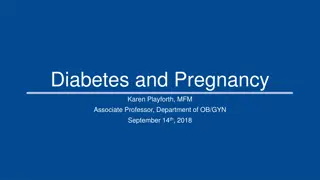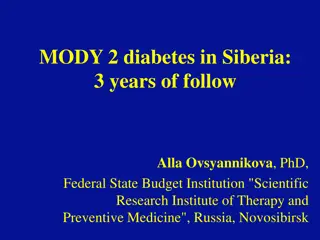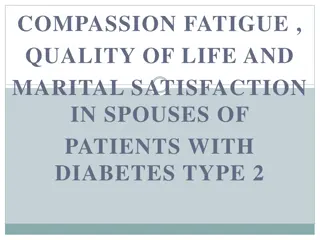Brittle Diabetes
Brittle diabetes is a rare condition causing severe instability in blood glucose levels, impacting daily life significantly. It is characterized by unpredictable hypoglycemia or ketoacidosis episodes, mainly affecting young women. The main causes include non-physiologic matching of meals/exercise and insulin administration, malabsorption, certain drugs, defective insulin absorption, and more. Autonomic neuropathy can lead to delayed stomach emptying, complicating insulin dosage timing. Effective management involves addressing psychosocial factors to improve outcomes.
Download Presentation

Please find below an Image/Link to download the presentation.
The content on the website is provided AS IS for your information and personal use only. It may not be sold, licensed, or shared on other websites without obtaining consent from the author.If you encounter any issues during the download, it is possible that the publisher has removed the file from their server.
You are allowed to download the files provided on this website for personal or commercial use, subject to the condition that they are used lawfully. All files are the property of their respective owners.
The content on the website is provided AS IS for your information and personal use only. It may not be sold, licensed, or shared on other websites without obtaining consent from the author.
E N D
Presentation Transcript
Brittle Diabetes . / 2019 20
Brittle diabetes is defined as severe instability of blood glucose levels with frequent and unpredictable episodes of hypoglycaemia or ketoacidosis that disrupts day to day life
Brittle diabetes is uncommon (less than 1% of insulin taking population) and it causes a huge burden on the patient due to multiple hospital admissions
It is episodic and almost always related to stressful life situations. It affects 3/1000 insulin dependent diabetic patients mainly young women.
Brittle diabetes is less common in people over 40 years of age which suggests that brittle diabetes may, in some cases, resolve itself in time
prognosis Its is poor with lower quality of life scores, more microvascular and pregnancy complications and shortened life expectancy
CAUSES OF BRITTLE DIABETES Main causes includes Non physiologic matching of meals/exercise and insulin administration. Malabsorption Certain Drugs (alcohol, antipsycotics) Defective insulin absorption or degradation Defect of hyperglycaemic hormones especially glucocorticoid and glucagon. Delayed gastric emptying as a result of autonomic neuropathy.
Autonomic neuropathy, nerve damage that affects the functioning of organs, can lead to problems with delayed stomach emptying (gastroparesis) and affect the functioning of the intestines. Not knowing when food will be digested can make it hard to judge when or how much insulin should be given.
Psycosocial factors are very important and factitious brittleness may lead to a self perpetuating condition. This is because of patient centred behavioral issues. Some of these problems may be short lived and related to a stressful situation (unhappiness at school or home).
Brittle diabetes is often associated with stress, depression and other psychological issues. Stress can lead to acute and temporary insulin resistance. This means that the body does not respond to insulin and this can come on and disappear very quickly without warning. This can lead to distinct challenges when needing to judge insulin doses. Additionally, other psychological issues may add further complications to the management of type 1 diabetes
CLINICAL MANIFESTATIONS Patients have wide swings of blood sugar levels and report differing blood sugar responses to the same dose and type of insulin. Most patients are in their twenties or thirties. Their glycated haemoglobin (HbA1c) are typically elevated (10-14%) and acute complications (DK and hypo) and chronic microvascular complications are commoner (67% versus 25%)
Brittle diabetics also had a lower quality of life score. The age of death ranges from 27-45 years with a predominance in young women. Those who survived had resolution of brittleness, but suffered a significant complication burden
clinical presentations Three clinical presentations of brittle diabetes have been described: (1) predominant hyperglycemia with recurrent ketoacidosis, (2) predominant hypoglycemia, and (3) mixed hyper- and hypoglycemia]. Frequent hypoglycemia, even if asymptomatic, causes both defective glucose counterregulation and hypoglycemia unawareness and, thus, a vicious cycle of recurrent hypoglycemia.
What are the Signs and Symptoms of Brittle Diabetes? The signs and symptoms of Brittle Diabates may fluctuate, depending on the glycemic status of the affected individual. The signs and symptoms of Brittle Diabetes caused by hyperglycemia: Thirst despite excessive drinking of water Excessive urination Weakness and severe fatigue Confusion Blurred vision
The signs and symptoms of Brittle Diabetes caused by hypoglycemia: Anxiety, confusion, or irritability Fatigue Heart palpitations Headaches Clammy skin, excessive sweating Shakiness/trembling, loss of coordination Numbness around the mouth Dilated pupils
Somogyi Effect . The Somogyi effect (or rebound hyperglycemia) results in morning high blood sugar (hyperglycemia) as a result very low blood sugar (hypoglycemia) during the night. It's a rare phenomenon and most often occurs in people with Type 1 diabetes.
dawn phenomenon Everyone has a dawn phenomenon. Otherwise they'd be too weak to get breakfast. But in people without diabetes, insulin levels also increase to handle the extra glucose. People with diabetes can't increase insulin levels that much, so their early morning blood glucose levels can rise dramatically
CLINICAL ALGORITHM TO DETERMINE THE ETIOLOGY The diagnostic algorithm was the glucose response to 0.1 unit / kg insulin administered subcutaneously and intravenously. If this response was normal then psycosocial evaluations were completed, including psycolinguistic and health psycological testing. Then other parameters affecting blood glucose concentration eg. gastric motility, counter regulatory hormones, Coeliac disease, hypothyroidism, adrenal insufficiency, insulin autoantibodies and most importantly patients compliance with prescribed regimens were assessed.
If the response were abnormal the location of the insulin resistance was identified as being subcutaneous, intravascular or at the peripheral tissue.
Frequent episodes of hypoglycemia can lead to hypoglycemic unawareness and make the condition worse. Keeping diabetes under good control for at least several weeks can restore hypoglycemic awareness. New technologies such as continuous glucose monitors and insulin pumps may help improve control.
Hypoglycemia unawareness (HU) is defined at the onset of neuroglycopenia before the appearance of autonomic warning symptoms. It is a major limitation to achieving tight diabetes and reduced quality of life. HU occurs in approximately 40% of people with type 1 diabetes mellitus (T1DM) and with less frequency in T2DM. Though the aetiology of HU is multifactorial, possible mechanisms include
chronic exposure to low blood glucose, antecedent hypoglycaemia, recurrent severe hypoglycaemia and the failure of counter-regulatory hormones. Clinically it manifests as the inability to recognise impeding hypoglycaemia by symptoms, but the mechanisms and mediators remain largely unknown. Prevention and management of HU is complex, and can only be achieved by a multifactorial intervention of clinical care and structured patient education by the diabetes team.
EVALUATION AND DIAGNOSIS A careful evaluation should be performed in patients with brittle diabetes. A detailed history as to the duration of diabetes, description of episodes of DK, severe hypos, presence of diabetic complications (particularly autonomic neuropathy) and prescribed insulin regimens should be taken.
It should also be determined if there was a period of stable diabetes preceeding the brittleness and what happened in the patient s life circumstances coincident with the onset of brittleness. Psycosocial factors need to be assessed. For patients with recurrent episodes of DK, a possible chronic cryptic infection (sinusitis, osteomyelitis, renal or perirenal abscess and lung abscess) should be excluded
For all patients a diabetic educational assessment is useful to evaluate whether the patients knows how to manage diabetes and rule out diabetes mismanagement (factitious brittle diabetes ) . In this case a in hospital assessment and management of blood sugar is necessary.
Iatrogenic hypoglycaemia is the result of the interplay of absolute or relative therapeutic insulin excess and compromised physiological and behavioural defences against falling plasma glucose concentrations in type 1 diabetes mellitus (T1DM) and advanced type 2 diabetes mellitus (T2DM).
What are the possible Complications of Brittle Diabetes? The complications of Brittle Diabetes may include those resulting from hypoglycemia as well as hyperglycemia: Hypoglycemia-related complications of Brittle Diabates: o Hypoglycemic unawareness o Loss of consciousness o Seizure o Risk of falls and injury due to seizures
Hyperglycemia-related complications of Brittle Diabetes: Progressive weakness Confusion Progression to ketoacidosis, which can cause accumulation of toxic ketones in the blood Kidney failure Seizures Risk of falls and injury due to seizures Coma The following complications may also occur in Brittle Diabetes: Frequent hospital visits; long hospital stays Reduced quality of life Complications may occur with or without treatment, and in some cases, due to treatment also.
MANAGEMENT Brittle diabetes is difficult to treat General principle Patients to be instructed how to match the insulin dose to the amount of carbohydrates ingested. Insulin regimens must be individually tailored to reduce the risk of hypoglycaemia while matching glycaemic control. The use of insulin analogues with ultrafast or ultraslow action and use of subcutaneous insulin pumps are effective in brittle diabetes.
SMBG is an excellent tool for the patients and a motivated patient can use this tool to manage his blood sugars. CGM (Continuous glucose monitoring) may further facilitate the understanding of glycaemic variability
Continuous glucose monitoring Typical diabetes management involves regular testing of your blood to check your glucose levels, often several times each day. With brittle diabetes, that may not be often enough to keep your glucose levels under control. With continuous glucose monitoring (CGM), a sensor is placed under your skin. This sensor constantly detects glucose levels in your tissues and can alert you when these levels get too high or too low. This allows you to treat your blood sugar issues right away.
Subcutaneous insulin pump The main goal for people with brittle diabetes is to better match the amount of insulin they get to how much they need at a given time. That s where the subcutaneous insulin pump comes in. It s the most effective tool for controlling brittle diabetes. You carry this small pump in your belt or pocket. The pump is attached to a narrow plastic tube that is connected to a needle. You insert the needle under your skin. You wear the system 24 hours a day, and it continuously pumps insulin into your body. It helps keep your insulin levels steady, which in turn helps keep your glucose levels on a more even keel.
Sensor augmented insulin pumps (an insulin pump with a CGM device) improves glycemic control without hypoglycaemia. Fully automated closed loop systems of insulin delivery based on CGM sensing (bionic pancreases) are available. This device also integrates glucagon delivery.
. In 2016, the Food and Drug Administration (FDA) approved a hybrid closed-loop system artificial pancreas that tests your glucose level every five minutes, 24 hours a day, automatically supplying you insulin as needed
Islet cell transplantation an effective therapeutic option entailing good expected outcomes. The limiting factor is the effect of immunosuppressive therapy and recurrence of autoimmunity
How can Brittle Diabetes be Prevented? In some cases, Brittle Diabetes may be prevented by considering the following factors: Following a treatment regimen, in order to maintain good glycemic index Regular physical activity Avoiding exercise on an empty stomach Eating meals on time (small meals at regular intervals, without lengthy gaps between large meals) Avoiding refined carbohydrate products in meals Limiting alcohol and caffeine consumption Seeking prompt medical attention for conditions that may pre-dispose an individual to Brittle Diabetes Regular medical screening at periodic intervals with tests and physical examinations
